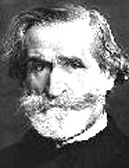

GIUSEPPE FORTUNINO FRANCESCO VERDI
10th October 1813 --- 27th January 1901
.
Copyright 1994-1998 Encyclopaedia Britannica
Last Updated on April 2025
By Steven Ritchie
And now for the Music

(3484)"Anvil Chorus". Sequenced by R.Steven Ritchie.
(3058)"Piano selection from Rigoletto". Sequenced by R.Steven Ritchie.
"Different selection of La Traviata". Sequenced by R.Steven Ritchie.
"Un Ballo in Maschera Selection". Sequenced by R.Steven Ritchie.
(1674)"La Traviata Selection". Sequenced by R.Steven Ritchie.
NEW (4658)"Forza del destino". Sequenced by Fernando Battaglino.
Thanks to Bill King for the music below.
"Rigoletto, Allegretto, Mov No.1" Sequenced by Bill King. "Rigoletto, Andante, Mov No.2". Sequenced by Bill King. "Di Provenza il mar, il suol". Sequenced by Bill King. "Oh mio rimorso! oh infamia". Sequenced by Bill King. "A un dottor della mia sorte". Sequenced by Bill King. "All'idea di quel metallo". Sequenced by Bill King. "La calunnia e ventacello". Sequenced by Bill King. "Chorus of the Hebrew Slaves". Sequenced by Bob Handforth. "Un Ballo in Maschera, Prelude to Act 1". Sequenced by Andrew Silverman "Un Ballo in Maschera, Prelude to Act 2". Sequenced by Andrew Silverman (357)"The Force of Destiny". Sequenced by Andrew Silverman (1617)"Overture to I Vespri Siciliani". Sequenced by David Siu. (1607)"Verdi's Requiem: 2. Dies irae (Part 1)". Sequenced by David Siu. Thanks to B.S. Lengton for the music below.
"From the opera Don Carlo, the preludio (the overture)". Sequenced by B.S.Lengton. "from the opera Don Carlo, he preludio of the 3rd act". Sequenced by B.S.Lengton. (2937)"La Donna Mobile (tenor & orchestra)". Sequenced by B.S.Lengton. (1603)"La Traviata No.1, Preludio". Sequenced by Kevin T. Perez (1604)"La Traviata No.2, Introduzione". Sequenced by Kevin T. Perez (1605)"La Traviata No.3 Brindisi". Sequenced by Kevin T. Perez (1608)"Rigoletto". Sequenced by Paulo Norberg (1609)"Lux aeterna from Requiem". Sequenced by Krzyszto Maslanka (1610)"Messa Da Requiem No.1". Sequenced by John Groves (1611)"La Traviata". Sequenced by M.Knezevic (358)"The one and only Anvil Chrous". Sequenced by Bob (775)"Aida". Sequencer by unknown

If you done any Classical pieces of say for example, Delius, mozart, and so on etc,
please email them to the classical music site with details to
"classical (@) ntlworld.com" written this way to stop spammers
just remove spaces and brackets for email address, thank you.

Visitors to this page --

Back to Classical Midi Main Menu click "HERE"